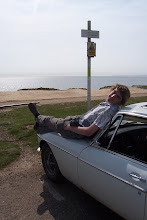I don’t want to use any filler on the GT if I can help it. Filler is for chavs, so they can hides the corrosion on their m*dern cars, and blend their rear spoilers on their front wheel drive cars. Filler is plastic, plastic is rubbish. I hate it. End of the story.
Filler is porus, all that is required is a hairline crack in the paint covering it, and water will be absorbed and held against the steel, and it will rust. Especially when it is used on seams, which are rarely completely water tight at the microscopic level. This sort of defeats the object of rebuilding the car. So I am going to avoid the use of filler altogether if I can help it, it was not used originally, so why should I need it?
I wanted to try lead loading ever since I read about it in the Haynes bodywork manual, on a beach in Cornwall shortly after buying Valleri. Speaking to people about it, it seemed to be an art which takes much practice and time to acquire, far superior to using filler, the proper, old fashioned way. I like this craftsmany stuff, and I had to try it!
Basically it involves melting lead, or a modern alloy with similar properties, onto steel panels. This can then be filed to shape easily as it is soft, and as lead is very uncreative, it will not corrode, and it will protect the surface of the steel beneath it. It is ideal. If you recall, I had repaired the scuttle, around the windscreen frame and where the front wing bolts on. It was the correct shape, but not completely even due to the grinding marks left from tidying up the welds. Time to lead load it, and being an idiot I presumed I could do it without practicing, besides I can’t afford enough material to waste practicing!
It’s quite simple, but difficult to describe. First you need a heat source. A modern gas torch will provide too fierce and precise a flame, which will burn rather than heat. The weapon of choice is a decent paraffin pressure blowlamp, I use a Primus No.630 which is a lovely quality bit of kit from the 1930s. Of course with any case of heat and metal, distortion will occur if too much heat goes in to large flat panels, so the first task it to “mask” off the area around that which is being leaded, by putting wet cloths anywhere which could be distorted. These will act as a heatsink, but even so the less time, and therefore less heat the process takes, the better.

Yours truly demonstrates the tools- a decent blowlamp, and a HUGE file! (Photo- sister)
The steel surface has to be really clean. Any discrepancies will mean the flux does not take, and the lead will not stick, so a good go with a wire brush in the drill is necessary. Then solder paint can be applied to the area. This is flux, with tiny grains of powdered lead in suspension. It must be stirred up thoroughly, as the lead immediately sinks to the bottom of the container. It is applied to an area slightly larger than that needing to be leaded, the acidic flux cleans the metal while the suspended lead tins the surface.
The blowlamp can be played over the solder paint, keeping it moving and bringing the temperature up evenly until the lead melts and the solder paint turns from grey to bright silver. Then it can be allowed to cool, and cleaned thoroughly with a damp rag to remove any excess flux and impurities which inevitably happen. The surface now has a very thin layer of lead over it, (it is “tinned”) so further lead can be melted into it to build up the required amount.
Vintage blowlamps do not really have a flame control as such, and are used full throttle, varying the distance between the lamp and panels to control the temperature. The stick of lead can be heated to the point where it is starting to soften, then the flame is brought onto the tinned panel at the right distance to start heating it up, while the solder stick is kept just below the molten temperature. When the thin layer of lead on the panel is melting, the solder stick is brought fully into the flame, and some blobs of solder are melted onto the panel. When enough is deposited, rough shaping can begin. I use a flat length of stainless steel to shape the lead, because I can’t afford a wooden paddle and the tallow required to stop it burning. This is the hardest part of the whole operation, getting the lead in the vague shape that is needed. Too much heat and it will melt and run, not enough and it is not possible to move. It’s something I can do, but not really describe.
Once the lead is near to the correct shape, it should be left. It is easy to try and get it just a bit better, then ruin it and have to start again. Once it has cooled, it is important to wipe off any excess flux, which is acidic and will rust metal quickly. Then shaping can begin, first with a coarse body file (8 teeth per inch or similar) and then with emery cloth of increasingly fine grades. Shavings form the body file, and any blobs of lead which run off, can be remelted and used again. I use a ladle and a Primus stove, to make ingots of lead for reuse as it’s expensive stuff. And there you have it- lead loading. It’s great fun. I enjoy it even more than welding, and that’s saying something.



No comments:
Post a Comment